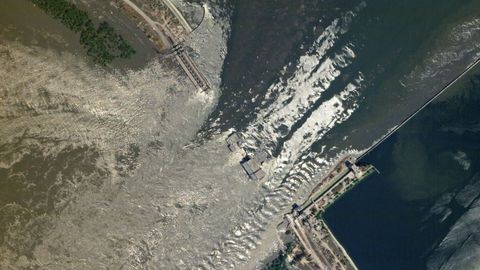
Satellite image of the damage to the Kajovka dam Reuters
Ukrainian scientists and lawyers argue that the international community should demand compensation from Russia for direct attacks on nature
The war in Ukraine not only destroys cities and towns where tens of thousands of innocent people live, but also poisons nature and thus creates additional economic damage. Air, water, soil, bioresources; there is not a single environment component to escape the harmful effects of conflict.
Terrorist attack on the Kakhovka hydroelectric power station
On the first day of the invasion, the Russian army captured the hydroelectric power plant in Coffee shop in the region Kherson. Months later, on the night of June 6, 2023, the dam was blown up.
«The Russian occupiers committed the greatest crime of ecocide“, the president of Ukraine said then, Vladimir Zelensky. “The destruction of the dam and reservoir is a human blow to the environment, after which nature will have to recover for decades.”
In the European Union, the destruction of the Kakhovka hydroelectric power plant is officially recognized as war crime of Russia. Its consequences shocked the whole world. The reservoir is located in the territory of three regions: Zaporozhye, Dnipropetrovsk and Kherson. Its length is 240 km. It was the largest in terms of volume in Ukraine. It contained 18,200 cubic meters of water which, when suddenly released, devastated everything in front of it and flooded both banks of the river, but especially the left side of Kherson because their houses were located on a lower level of the ground.
Now, the Kakhovka reservoir no longer exists. The long-term environmental and socioeconomic implications of this are hard to gauge, but they don’t look good. Water from the reservoir provided irrigation for almost the entire southern Ukraine; Namely, for 94% of agricultural land in the Kherson region, almost 75% in Zaporozhye and 30% in Dnipropetrovsk. In full, this area produces almost 80% of all vegetables in Ukraine. Even the Crimean peninsula was affected, as the Kakhovka reservoir was the only one supplying the North Crimean Canal.
Missiles, mines and corpses
Chemical pollution in Ukraine is huge. Carcinogenic chemicals released into the air when rockets explode poison everything they touch. Missile fuel is also toxic.: Heavy metals and compounds enter the soil and poison the groundwater.
Missiles that hit strategic facilities and companies of the chemical industry increase the risk of large-scale environmental disasters. The broken and burned military equipment left in the fields is also not safe, as it is the remains of oil products and rusted scrap iron. Both detonated and unexploded mines are also extremely harmful because the heavy metals they contain easily accumulate in the soil.
Even mass graves cannot be considered safe given their potential for breeding and spreading disease.
Ukraine documents every case of environmental damage. Dozens of mobile groups of Ukrainian scientists and lawyers are working on this in close cooperation with foreign activists. Its goal is for the international community to demand compensation from Russia, not only for direct attacks on people and infrastructure, but also for a veil of poison, destruction and pollution which he left behind in the plains, forests and rivers of the earth.
Source: La Vozde Galicia
I am Amelia James, a passionate journalist with a deep-rooted interest in current affairs. I have more than five years of experience in the media industry, working both as an author and editor for 24 Instant News. My main focus lies in international news, particularly regional conflicts and political issues around the world.







